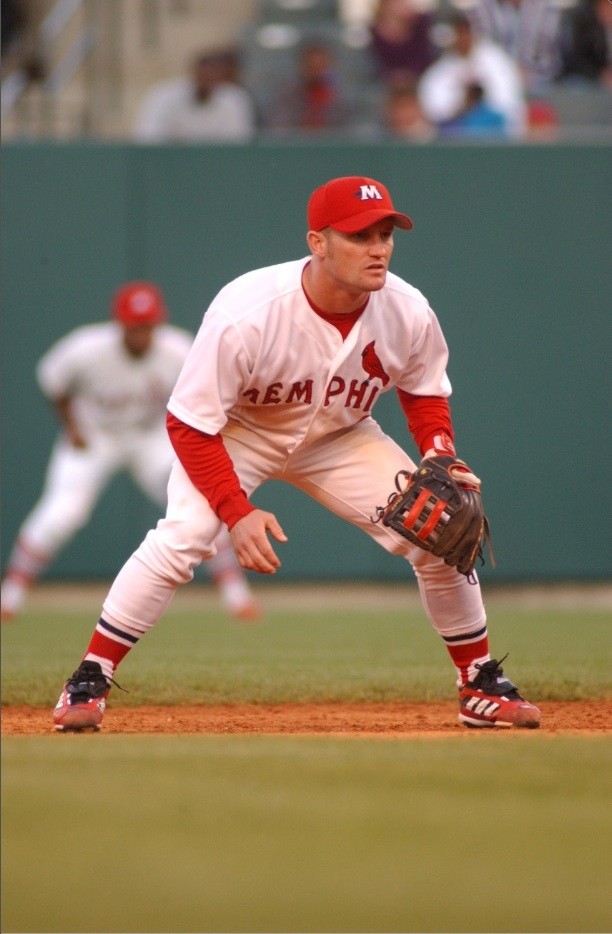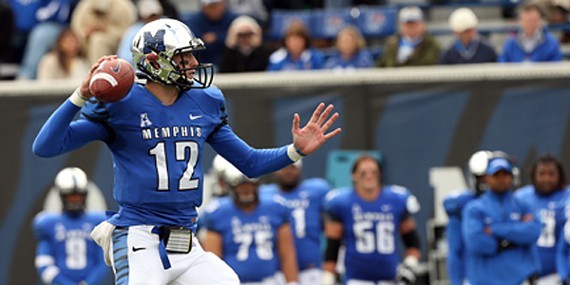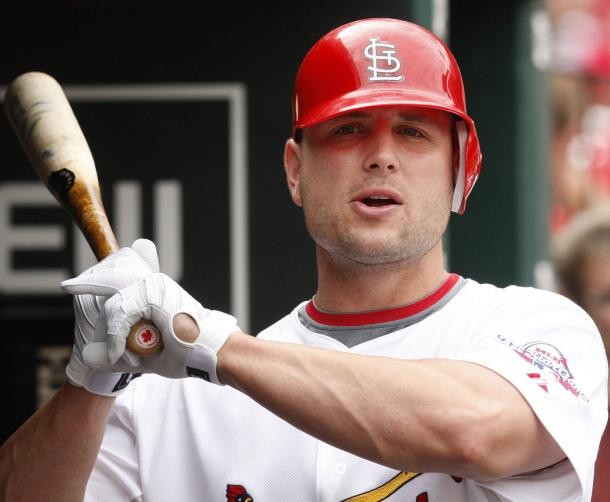When the St. Louis Cardinals were swept by the Boston Red Sox in the 2004 World Series, exactly one of their everyday players had come up through the Cards’ minor-league system. (He was first baseman Albert Pujols, a diamond in the rough, to say the least.) Fast forward to October 27, 2011. When Allen Craig caught a fly ball off the bat of Texas Ranger David Murphy to clinch the Cardinals’ 11th World Series championship, seven of the nine players on the field at Busch Stadium were farm-raised (and played in Memphis for the Redbirds).
This season, for the first time since the Cardinals’ Triple-A affiliate moved to the Bluff City in 1998, four of the Cardinals’ five starting pitchers on opening day were former Redbirds. (Adam Wainwright, Jaime Garcia, Lance Lynn, and Shelby Miller have combined to win 29 games through Sunday, despite Garcia being on the disabled list since May 19th.)
From Last to First
In 2005, the St. Louis farm system was ranked 30th by Baseball America. (That’s dead last.) As recently as 2010, the system ranked 29th. But now, in 2013? The Cardinals system is ranked first among all major-league clubs.
How has such a large collection of managers, coaches, and players — the Cardinals system features seven minor-league teams — made such a dramatic and positive transition in so short a period of time? The change began, ironically enough, after the Cardinals beat the Detroit Tigers to win the 2006 World Series. That team snuck into the playoffs with an 83-78 record, then played its best baseball of the season in October. But the supporting cast around Pujols — veteran stars such as Jim Edmonds, Scott Rolen, and David Eckstein — had grown old. St. Louis followed up its championship with a dud of a 2007 season (78-84). Edmonds, Rolen, and Eckstein departed and general manager Walt Jocketty was replaced by John Mozeliak. A franchise famous for the first extensive farm system in the game (in the 1920s and 1930s) shifted its core philosophy back to player development.
When the iconic Pujols departed for a 10-year, $254 million contract with the Los Angeles Angels after the 2011 championship season, the Cardinals gave his position to Craig, an 8th-round draft pick in 2006. (Craig was paid $475,000 in 2012 and drove in 92 runs, 13 fewer than Pujols did for the Angels.) When former Cy Young winner Chris Carpenter was forced into retirement by a nerve condition in his pitching arm this spring, the Cardinals gave his spot in the rotation to Miller, the club’s top pick in the 2009 draft. Farm-grown talent is inexpensive (until free agency arrives after six seasons in the majors), but can it keep a proud franchise among pennant contenders one year after another?
John Vuch is the Cardinals’ director of minor-league operations and has been with the franchise since 1979. He relishes the Cardinals’ climb up minor-league rankings but says it starts at the top. “There was somewhat of a philosophical change,” Vuch says, “in terms of taking our lead from the major-league staff and developing continuity — doing the same things in St. Louis, Memphis, Springfield, and all the way down to our Gulf Coast League teams and our Dominican academy. Players go from level to level, and they know what to expect. No surprises. That’s helped a lot.”
The first half of the 2013 season has accentuated the value of the Cardinals’ farm system, as one pitcher after another has either struggled on the mound or been forced to the disabled list by injury. In early May, veterans Mitchell Boggs and Marc Rzepczynski, having been knocked out of the St. Louis bullpen, were demoted and replaced on the Cardinals roster by Seth Maness and Carlos Martinez (a 21-year-old flame-thrower promoted from Double-A Springfield). Maness and Martinez each pitched a scoreless inning in relief of yet another rookie (Shelby Miller) in a May 3rd victory at Milwaukee. Then when veteran Jake Westbrook was forced to the DL with elbow inflammation, John Gast filled the rotation slot and won his first two big-league starts. (Gast opened this season with an astounding 32 consecutive scoreless innings for Memphis.) When Garcia was shut down for the season on May 19th, Tyler Lyons left the Memphis rotation and won his first two starts for the Cardinals, retiring 17 Kansas City Royals in a row on May 28th. Home-run hitters may sell tickets and boost TV ratings, but pitching depth gets teams to October and playoff baseball.
“A few years ago,” Vuch says, “[former Cardinals pitching coach] Dave Duncan wanted us to develop more power pitchers. So we talked to our amateur scouting department and our pitching instructors. It’s one thing to have power arms, but Dunc’s philosophy has always been quality strikes, down in the zone. It’s not so much what type of delivery a pitcher uses, as long as he gets results.”
“The Cardinal Way”
The cover story in the May 27th issue of Sports Illustrated presented the St. Louis Cardinals as Major League Baseball’s model franchise, from the top down. If anyone is familiar with “the Cardinal Way” (as SI put it), it’s Ron (Pop) Warner, the Redbirds’ second-year manager. Warner was drafted by the Cardinals in 1991, played for the original 1998 Memphis Redbirds, and has coached or managed in the Cardinals system since retiring as a player after the 1999 season.
Warner acknowledges talent is the fundamental and most obvious factor in the revival of the Cardinals system. But he points out a less tangible factor that may come closer to revealing a philosophy … or “way.”
“We’re finding players with really good make-up,” Warner says. “If you get high make-up guys, they grind, they compete really hard. When you get guys like that, you find successful people … not just at baseball, but life. Combine that with talent, and you’ve got something. It makes it a lot easier for us to develop players.”
And how exactly can “high make-up” be recognized in a prospect? “It’s tough,” Warner says. “You look into a player’s background and find as much information as you can about them. We’re drafting guys who perform well in college. And usually when a player is performing well in college, there’s a reason: They’re tough, they compete. They may not be the most skilled players, but they figure out how to get it done. High aptitude: They listen, they want to learn and get better. And they actually try to apply what you teach them.”
Warner’s job is to prepare players for the major leagues, whether it’s over several seasons or as an emergency injury replacement. He’s also preparing future Cardinals, emphasizing the details in game-day preparation — that “way” again — that translate into wins at Busch Stadium. Even with the high roster fluctuation, the details have made a difference in Memphis, too, as the Redbirds are leading their division of the Pacific Coast League.
“You show up every day, and you’re a professional on and off the field,” Warner emphasizes. “It’s a privilege to wear this jersey. There’s a lot of history behind wearing the birds on the bat on your chest. We teach through fundamentals. We’ve never tried to find an identity. You make sure the little things that come along in a game are taken care of and play a hard nine innings. If we execute better than the other team, we know we have a chance to win.” Warner notes cases where a player may get “sideways” with his game-day preparation — swings in the batting cage, soft-toss, a baseball player’s grunt work — when he has to step in and remind the player that details matter in the climb up a minor-league ladder.
Three members of the 2013 Redbirds haven’t needed much reminding.
Second to None
For a franchise that has won as consistently as the Cardinals have since 2000, second base has been a remarkably volatile position. Since Fernando Vina went down with a hamstring injury during the 2003 season, St. Louis has turned to the following gaggle of infielders — one of them originally an outfielder — to man the position: Bo Hart, Tony Womack, Mark Grudzielanek, Ronnie Belliard, Aaron Miles, Adam Kennedy, Skip Schumaker, and Dan Descalso. This season, a natural third-baseman — Matt Carpenter — has been learning the less-than-natural art of turning a double play from the right side of the infield. The franchise that gave us Rogers Hornsby and Red Schoendienst has found itself challenged at securing a steady second-baseman.
Along comes Kolten Wong. At 5’9″ and 185 pounds, Wong’s size all but precludes him from playing anywhere except the middle infield. Good thing he plays second base so well. Drafted in the first round by St. Louis in 2011, Wong has already won two championships as a pro, with Class-A Quad Cities (Midwest League) in 2011 and Double-A Springfield (Texas League) in 2012. Wong was a Texas League All-Star last season when he hit .287 and stole 21 bases. According to Baseball America, Wong is the 84th-ranked prospect in all of baseball and tops among second-basemen. The 22-year-old native of Hilo, Hawaii, has hit .321 (through Sunday) for the Redbirds and was named the Cardinals’ minor-league Player of the Month for May.
“Kolten’s better defensively than I thought he would be,” Warner says, “this being just his second full season. Smooth. I thought we’d have to work on turning double plays. He’s pretty polished. His hands work with his feet. And he stays in a good hitting position.” Could Wong be a long-term solution for the Cardinals at a position that’s long been a game of musical chairs? “If he keeps developing the way he has so far,” Warner says, “I see no reason he can’t be that guy someday.”
Wong has fully embraced Cardinals culture, that much-talked-about “way.” He’s relished the wisdom handed down by veteran teammates like Rob Johnson and Brock Peterson, the small tips that paint a big picture for rising prospects. “You know how to win,” Wong says. “You know how to carry yourself and the expectations on the way to St. Louis. You’re constantly trained that this is a winning organization, and nothing less is expected. It’s a mindset, and it rubs off on every player. No shortcuts. Do whatever you need to do to be ready for the next level.”
“He Was Raised Right”
Redbirds pitching coach Bryan Eversgerd was raving about Michael Wacha before the big righty threw his first Triple-A pitch, and it really didn’t have much to do with his arm. “You can tell he was raised right,” said Eversgerd in early April. “He’s got his head on straight. So mature, great in the clubhouse.”
Drafted by the Cardinals in the first round of the 2012 draft after a stellar college career at Texas A&M, Wacha caught the parent club’s attention this spring when he did not allow an earned run in 11 spring-training innings. He was leading the Pacific Coast League with an ERA of 2.05 (nine starts) on May 30th when he was summoned to St. Louis to fill the rotation spot vacated when Gast was sidelined with shoulder discomfort. Wacha somehow met the hyped anticipation in his debut, holding Kansas City to two hits over seven innings. (The Cardinals’ bullpen allowed three runs in the ninth to cost Wacha the win.)
During spring training, one veteran umpire described Wacha’s changeup as the best he’d ever seen. (Disclosure: The umpire was Angel Hernandez, now infamous for having missed a home-run call this season, even after the help of video review.) As impressive as his pitching arsenal may be, Wacha’s maturity and comportment on the mound have caught the most attention throughout the Cardinals system. (Wacha turns 22 on July 1st.)
Warner describes a game earlier this season when Wacha pitched against a PCL team that liked to run early in the count. They had a conversation before the game about the importance of the pitcher holding his stretch position a bit longer to disrupt timing and stall those baserunners. By pausing in his stretch and extending glances, Wacha proceeded to shut down that running game in a Memphis win.
“When you talk to him, he looks you in the eyes,” Warner says. “He’s listening to you. That’s something I always look for in a young player. Most guys, when a game heats up, they’ll start worrying about the situation at hand. But [Wacha] can slow things down. He doesn’t scare at all. It’s one of the keys to this game.”
The Prodigy
The most common comparison is with Vladimir Guerrero, the Hall of Fame-bound outfielder who hit .318 with 449 home runs, 181 stolen bases, and nine All-Star Game appearances over 16 major-league seasons, primarily with the Montreal Expos and Los Angeles Angels. Like Guerrero, Oscar Taveras hails from the Dominican Republic and, like Guerrero, Taveras has displayed — in bold fashion — a batter’s most revered skill: putting the thick part of the bat on the baseball, wherever the ball is pitched. Connect with the ball on a bat’s “sweet spot,” and good things tend to happen.
“Oscar can hit an assortment of pitches,” Warner says, “and they don’t have to be strikes. But he can hit them. At some point, he’ll have to shrink [that strike zone] some. But we don’t want to take away that talent of his: centering pitches that other hitters simply can’t.”
Taveras is the third-ranked prospect in minor-league baseball, according to Baseball America. Since 1990, he’s only the third non-pitcher in the Cardinals system to be ranked so highly (J.D. Drew was number one in 1999, Colby Rasmus number three in 2009). Taveras does Wong one better with three pro championships to his credit (he helped Johnson City to the Appalachian League title in 2010). He was named Texas League Player of the Year for Springfield in 2012, when he led the circuit in batting (.321) while hitting 23 homers and driving in 94 runs (in 124 games). The only thing keeping him out of the St. Louis outfield this season is sensitivity to his young age (Taveras turns 21 on June 19th) and his “free agency clock” (the earlier a player starts his major-league career, the earlier he’ll be eligible for the fat contract of a bidding war between teams).
Taveras recently missed almost a month of action with a lingering right-ankle injury, so his numbers — .315 batting average, four homers, and 20 RBIs — aren’t what Cardinals fans might have expected. No matter. As so many young players have shown after recent stints (long or short) at AutoZone Park, it’s the numbers produced with two birds on their jersey that will be long remembered.
 Greg Cravens
Greg Cravens 
 Roger Cotton
Roger Cotton 


